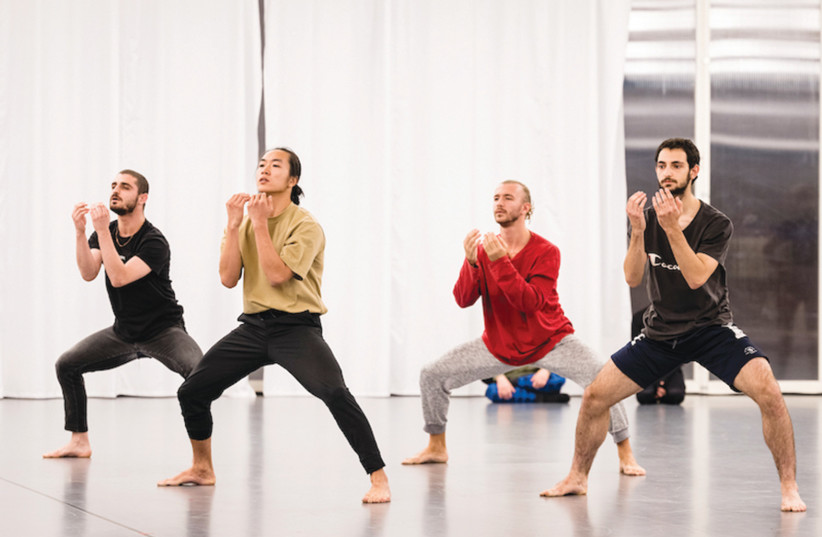It is difficult to describe the atmosphere created by Ohad Naharin’s new work for Batsheva Dance Company. And perhaps that is one of the defining factors of any great work of art that it is impossible to describe and thus, irresistible to see.
MOMO, which was created in collaboration with Ariel Cohen and the company dancers, seems to hark back in spirit to some of Naharin’s earlier works in its intensity and musicality.
The piece, as Naharin described it, is actually two conjoined works running alongside one another. The first is a quartet performed by dancers Yoni Simon, Igor Ptashenchuk, Li-En Hsu and Guy Davidson, or “the boys” as Naharin refers to them. The second is performed by seven dancers, male and female, and has two casts. Essentially, the boys remain constant while the cast of seven rotates. All of this is set to a score that includes Laurie Anderson and the Kronos Quartet, Phillip Glass and a Venezuelan artist named Arca. There is a marked distinction in rhythm between these two groups; the quartet moves slowly and smoothly, anchoring the downbeat of the music, while the larger group works with the accelerated beat. Though it requires the audience to split focus, the dissonance is hypnotizing.
“Chaos is something that does not frighten us in the least. The opposite is true. Chaos is very present in the how and the way of how we work. In dance, we have the ability to use chaos to speak about what we want to speak about.”
Ohad Naharin
“Chaos,” Naharin informed the audience at a packed press conference, “is something that does not frighten us in the least. The opposite is true. Chaos is very present in the how and the way of how we work. In dance, we have the ability to use chaos to speak about what we want to speak about.”

Chaos in the dance
An element that will certainly catch viewers’ eyes and imaginations is a large climbing wall covering the back wall of the stage. At one point, the boys climb up to the highest perches, sitting above their fellow dancers and keeping watch. Another set element is a number of ballet barres, which provide a moment of comedic release from the intensity and also appear to be a comment on the rigidity of classical dance methods.
DURING THE creative process, Naharin once again worked closely with former company member Ariel Cohen. Cohen has been a key member of Naharin’s artistic team for the past several years both as a costume designer and an artistic assistant, having contributed to Venezuela, Sadeh21, The Hole, Last Work and 2019. “He has been in processes with me for the last 10 years. He is one of the most special people I have ever met,” said Naharin. “He can send me a video from YouTube, a picture or music that sends me to a whole new place that I wouldn’t get to otherwise. He was a key element in generating material for ‘MOMO’.”
“Ohad was very ready to share the creation, which is this complex equation, with me, the dancers and the other collaborators, such as Eri Nakamura, who designed the costumes, and Bambi (Avi Yona Bueno), who designed the lights. He is able to embrace everyone and to let everyone into the creation,” said Cohen on a later day over coffee.
“I love to be part of the searching enterprise that is Batsheva; to influence and be influenced. Batsheva is the pearl of Western dance practices and it is very important to me as a dancer, artist and performer.”
Cohen spent many years studying and exploring dance practices first in Israel and then around the world. “My search in dance didn’t start with Ohad but his is one of my favorite offerings in the world. I am learning so much about dance, the dance world and life working with him. You know, sometimes you can hear someone singing well and though you don’t necessarily start singing like them, they have taught you something about how to sing. Ohad has this immense body of knowledge that succeeds in inspiring others to generate movement. That is incredible.”
The title was drawn from several sources. Nakamura told Naharin that the word “mo” in Japanese means “also.” As the piece is made from two parts, Naharin felt that MOMO was a good reflection on that fact, it also rolls off the tongue nicely. Then the dancers informed him that MOMO is also an acronym for Magic of Missing Out. The piece was created in part during a residency in the removed Orsolina28 in Moncalvo, Italy.
In watching the segments, it seemed the work embraces the fact that one can never be everywhere or watch everything at once. Life happens and we catch what we catch. Instead of focusing on FOMO, what we were missing, the piece urges its audience to accept that they will inevitably miss out on some moments.
MOMO will be presented at the Suzanne Dellal Center on December 10, 12, 20-23. For more information and tickets, please visit: https://batsheva.co.il/he/schedule/?show_id=1944.
